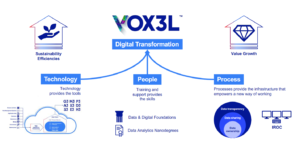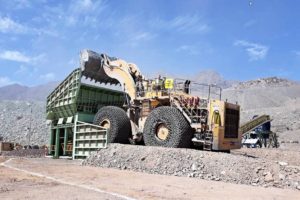There is a lot to take in from Anglo American’s technology update which was presented today by Tony O’Neill, the Group Technical Director, but what stands out is the comprehensive nature of its projects, which of course take in FutureSmart Mining™ Technologies from bulk ore sorting to coarse particle recovery, hydraulic dry stacking, microwave mining and hydrogen mining trucks. But beyond these there is a bigger picture through its P101 operational excellence approach, use of Advanced Process Control and digitalisation through VOXEL™ – all part of what O’Neill refers to as a new trajectory for mining.
It really does feel like the brainstorming Open Forum sessions Anglo American started in the mid-2010s have filtered through to innovation in action on an unprecedented scale. It is fair to say that no other global miner has taken on the future of mining in such a coordinated way, from liason with external stakeholders to applying new technology across the operational playing field from exploration to remediation and everything in between.
O’Neill commented: “Technology and innovation are central to how we are creating a more sustainable business – for our shareholders, our employees and our stakeholders across society. Across every aspect of our business, from mineral exploration to delivering our products to our customers, we are thinking innovatively to ensure the safety of our people, to enhance the sustainability of our business, and to deliver enduring value in its many forms for all our stakeholders. Our Operating Model provides stability and predictability to our performance, with P101 layered on to deliver new benchmark levels of performance across our operations. FutureSmart Mining is then integrating technology and digitalisation with the full spectrum of our Sustainable Mining Plan ambitions – particularly our water and energy targets and our pathway to carbon neutral operations by 2040. Together, our approach is providing the next step-change in our operating and financial performance.”
P101 – value delivery & continuous improvement across all processes
Taking each area in turn, P101 is Anglo’s breakthrough productivity program with initiatives focused on delivering industry leading performance and productivity across all its key plant and equipment – it is there to ensure integration across all processes and is focused on value delivery. An example is tactical mine design – planning the mine around the equipment and enabling high plan compliance plus further incorporating safety in design. This has been a key contributor to delivering >25% improvement in shovel productivity at some of its operations.
In blasting, the company is using fragmentation models enabling fit-for-purpose designs; with improved fragmentation delivering improved truck and shovel payloads and milling rates. There is a focus on eliminating unproductive trim/buffer blasts with 20-50% reduction in number of weekly blasts achieved, plus ~50% improved shovel loading rates in trim blast areas. In blasting practices there has been a 50% improvement in drill and blast execution vs plan, enabled via real-time, in-field digital platforms.
Anglo is also using haul road digital twins to analyse and improve existing haul roads. At Mogalakwena, it has seen a 23% reduction in haul cycle time; plus 40% improvement in truck average empty speeds on the main haul cycle. It also locks in benefits during the design phase of future haul roads.
Moving on to processing and throughput – P101 has involved systematic debottlenecking through dynamic modelling enabling targeted process design upgrades. Circuit reconfiguration has been used to achieve increased process efficiency utilising existing infrastructure. Examples include a 7% year on year increase in the Minas-Rio throughput rate. On run time, remote asset monitoring anticipate maintenances and models optimum shutdown strategues. Implementation of asset tactics, spares management and improved material handling reduce blockages and improve plant stability and runtime. A 12% increase in weekly direct operating hours were achieved at the Moranbah Coal Complex.

In recovery, geometallurgical modelling is used to tailor operating parameters to mined material. It includes areas like reagent optimisation and operating parameter adjustment. A 2% increase was achieved in Minas-Rio mass recovery. Finally on revenue, optimising ore blends tailors products to customer’s value in-use. A good example is defining drill and blast requirements, optimising crusher settings and screen configurations to preserve and maximise lump iron ore equating to a 5% improvement in Kumba Iron Ore’s lump:fine ratio.
Overall the tangible P101 value is significant – over $2 billion in gross run rate improvement in 2020 vs a 2017 baseline.
The role of Advanced Process Control
In many ways the invisible efficiency contributor, APC automates stability of plant processes. Using APC alone, Minas-Rio has seen a 48% increased stability in the float circuit, lifting throughput by 4% while at Anglo American Los Bronces, SAG mill throughput was maintained at 32% greater stability with 17% reduction in energy per tonne milled.
APC also has a big sustainability upside. Sustainability benefits achieved include a 4% reduction in water consumption at Los Bronces grinding mills; 4-12% energy reductions from APCs controlling SAG mills; 80% reduction in plant micro-stoppages from plant-wide optimisers in South Africa and Brazil; minimised product loss and improved water efficiency from fibre optic sensor wraps that surround piping to dynamically model the flow of metal in process as well as a reduction in maintenance of high-value moving parts including motors, pumps and conveyor belts.
VOXEL™ industry-first digital transformation platform for data-driven decisions
Anglo says its VOXEL digitalisation platform differs from others used in the market in a number of ways – first it was designed for mining not just equipment. Second it spans the full value chain and is not just focussed on equipment health. Third it leverages technical and sustainability knowledge not only other industry knowledge. And last, it includes digital twins of the entire value chain, not just one asset. At the base of VOXEL is a Microsoft infrastructure but above that Anglo has full-stack IP ownership.

Central to VOXEL is an integrated data lake from which everything else is structured. It is being used for Rapid Resource Modelling, creating a digital version of the ground in which the miner operates to provide an ‘always right’ model of ore concentrations plus Asset Maintenance Optimisation, ensuring that maintenance on assets is carried out with the least impact on costs and plans overall and in the long-term. In Mine Planning, it is helping to optimise the plan to extract the required ore for the greatest value, with the least environmental impact, safely. For Safety & Health it can be used to detect patterns and optimise tactics that minimise safety risks and maximise healthy working practices. Processing Planning uses VOXEL to optimise the plan to safely process the required ore for the greatest value, with the least impact. At a staff level, People & Process digitalisation can be used to encourage and support people to ensure they are ready and able to identify and exploit opportunities presented by the technology. Digital Operational Planning allows simulation of the value chain to produce the optimal outcome while above all digitalisation will help deliver sustainable outcomes.
VOXEL is also helping enable digitally-enabled specialists to work remotely, exemplified at a large scale by the new Integrated Remote Operations Centre (IROC) for Los Bronces in Santiago.
FutureSmartMining™ integrating technology & sustainability
Lastly, the presentation moved to more familiar ground and progress with FutureSmartMining which has four arms – namely Concentrating the Mine, the Water-less Mine, the Modern Mine and the Intelligent Mine. For the first of these, bulk sorting is a great example – performing pre-concentration of mined ore early in the value chain, rejecting parcels of unwanted material from the ore stream, increasing plant grade. The bulk sorting system at Mogalakwena has allowed rarly rejection of waste increasing plant grades and metal output, as well as reducing energy and water intensity with mass reject of 5-20%. Full system delivery beyond the pilot is being implemented in 2021 with rollouts at Barro Alto 2021/2022 and Los Bronces 2021-2023 while other sites are under study.
Another good example is Coarse Particle Recovery (sometimes called Coarse Particle Flotation). It will be used at Quellaveco allowing increased throughput by recovering metal at larger particle sizes with 10-20% less energy and wet tailings and up to 85% water recovery with hydraulic dry stacking plus up to 4% production increase through tailings retreatment. Overall for the Peruvian copper mine it will mean an additional ~12-35% production. Other rollouts are set for Los Bronces 2023, Minas-Rio 2023 while Anglo with partner Glencore is investigating options for Collahuasi. Hydraulic dry stacking is being trialled this year at El Soldado.

The hydrogen truck project will see first motion of a hybrid FCEV converted Komatsu 930E truck at Mogalakwena later this year but is part of a wider move to implement low cost, clean renewable energy at mine sites – these trucks will make a significant impact on Scope 1 GHG emissions. The hydrogen plant and linked solar PV array will be ready at Mogalakwena in Q4 2021 with a scale up to 2024, with expected electrolyser capacity to reach above 100 MW. There is the potential to eliminate 46% of diesel related GHG emissions equivalent to 1 Mt CO2e/y. Some seven sites are expected to have renewable power and hydrogen by 2030, plus the associated FCEV truck fleets.
An interesting update was also given on the use of microwaves to selectively fracture rock along mineral grain boundaries reducing the hardness of the material, and enhancing process recovery through improved liberation. Microwave energy will be used to precondition ores, increasing throughput and recovery as well as reducing energy and water intensity. It also allows a hardness reduction in ores. Rollouts are happening at Los Bronces, Mogalakwena, Collahuasi and Quellaveco.
And carbon neutrality
A final focus was made on achieving carbon neutrality. Anglo is focusing on six levers which, when connected, provide the architecture for a zero carbon future:
- Renewable energy generation: developing a supply of renewable power generation to deliver reliable carbon free electricity;
- Hydrogen generation: developing an integrated green hydrogen production and enabling fuel switching from diesel;
- Energy storage: attractive options to enable 24/7 access to renewable generation and stability are arising;
- Methane capture: leveraging developing technologies to substantially abate vent-air methane, and enhance the safety of operations;
- Energy efficiency: improvements in operational efficiency are significantly decreasing carbon emissions and costs and will continue into the future; and
- Emissions compensation: for the remaining hard-to-eliminate emissions, Anglo is developing a pipeline of technology and nature-based CO2 sequestration and inset solutions.











